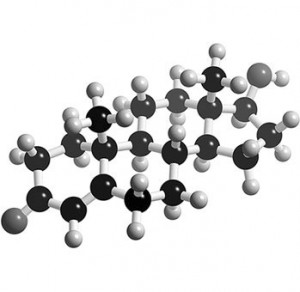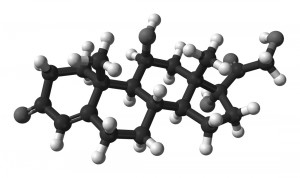“If we’re going on chest hair, that’s the highest group over there. We’re middle. And those guys are last,” one rugby player quips.
He is trying to predict which of the groups of his teammates has the highest “T-factor” – testosterone level – and which has the lowest.
But it turns out that chest hair isn’t necessarily a good predictor of men’s testosterone levels – as the rugby player found out along with the thousands of people nation-wide who watched the National Geographic special “Testosterone Factor” this February.
It turns out – for humans at least – that change in testosterone levels (as compared to a man’s normal baseline) is more instructive because many different environmental stimuli can affect local testosterone levels.
For instance, as the National Geographic investigation discovered, after the Potomic Athletic Club rugby team won a match against their rivals, their testosterone levels were significantly higher than when they started the match and higher than their mid-game levels. Contrastingly, the losers experienced a testosterone drop at the end of the competition.
Stephanie Anestis (GRAD ’05), a guest star on “Testosterone Factor,” lecturer in the department of anthropology, and a Schwartz Foundation post-doctoral research associate in the Center for Human and Primate Reproductive Ecology, is investigating this phenomenon in chimpanzees.
She has found a positive correlation between baseline testosterone levels, dominance rank, and aggressive behavior in chimps, as well as a negative correlation between the T-factor and aggression received.
Anestis hypothesizes that this is because chimps who win competitions get a testosterone boost and are primed to take on the next competitor. If they win again, they get another boost. This constant testosterone high leads to higher base levels.
Naturally, the chimps that are constantly winning fights are going to be the highranking individuals. On the other hand, individuals who lose fights are going to lose rank; a corresponding drop in testosterone tells them to not take on any more competitors when they are unlikely to win.
We’re not the only ones that get stressed out
Anestis’s work looks at how various hormones influence behavior. While she generally uses chimp models, she is also interested in the implications of her findings for human behavior. One project for which this connection is particularly salient has been the investigation of cortisol, which is highly correlated with the stress response across many different species.
Typically, higher levels of cortisol in the blood stream indicate higher levels of stress. The stress response is an adaptive mechanism that enables organisms to respond appropriately to threatening situations.
Immediate stressors lead to short, quick rises in cortisol levels that allow you to duck when you notice a baseball hurtling towards your head or enable a chimp to flee from a hungry predator.
However, cortisol can be dangerous when we are constantly exposed to it. It can cause chronic high blood pressure, cripple our immune responses to dangerous pathogens, and throw off the balance of glucose in our blood streams. Chimps, too, can get stressed out.


At first, this may be surprising. After all, it seems that the reason stress is dangerous to humans is because we build unnaturally stressor-laden environments for ourselves.
We engage with so many stressors so often, that the stress-response is excessively triggered so that its effects – though perhaps good for a quick burst of energy – end up wearing down our bodies. Evolution has not had time to correct for this yet, making the stress-response maladaptive.
Chimps don’t have papers to write, though, and they’re not I-bankers working 18-hour days, but there is actually a lot in common between chimp and human societies. Chimps have families to feed and protect, mates to woo, and superiors to impress. “Life becomes stressful when any individual can ruminate about its position in a social group,” Anestis explains.
In particular, it would seem like low-ranking chimps would be the most stressed out. After all, they’re constantly being picked on by the guys on top.
“The thinking is that if you’re an alpha and having a bad day,” says Anestis, “You can slap a lower level chimp to feel better about yourself and relieve some stress. Low-ranking chimps don’t have that outlet.”
However, the evidence supporting this hypothesis is conflicting. Some studies find a positive correlation between cortisol – find no such correlation.
Anestis looked at cortisol level changes when chimps were put through a stressful procedure – sedation with ketamine
hydrochloride. She found that while cortisol levels in response to sedation varied with age, there was no discernable pattern based on rank.
This led Anestis to start thinking about other factors that might predict stress. Inspired by the work of Robert Sapolsky who looked at dominance styles in baboons and their implications for endocrine correlate levels, Anestis hypothesized that personality type, or behavior style, would be a better predictor of cortisol level than rank.
Type A chimps?
Anestis took the project to her field site in Louisiana, The New Iberia Research Center, to ask the question. “Chimps have different personalities,” Anestis explains. For instance, chimps differ in how much they care about achieving high rank.
Once they achieve high rank, some chimps bully others all the time and are constantly picking fights. Some maintain their rank with more subtle cues and do a lot of grooming.
“Researchers have known this for years,” Anestis continues. “But measuring personality is a stumbling block because you can’t give a chimp a questionnaire.” What you can do is give their caretakers a survey. And researchers have. Furthermore, it turns out that when caretakers report on chimp personality styles, the surveys are surprisingly reliable, which made Anestis cautious.
Once she began to spend time with the humans who hung around the chimps, she noticed a distinct dialectic among them: “The whole day everyone talks about who Hayden was picking on, and what Jeffery did, and who Rachel groomed. Everyone hates Hayden because he’s mean to the care-takers and everyone loves Rachel.” Thus, the reason the surveys were so consistent was that each monkey was already stereotyped by the caretakers.
Anestis observed the chimps for hundreds of hours, recording their actions and then grouping the actions into categories. “Any observational method is going to be a little biased,” she admits. “But I’m trying to drastically reduce that bias.”
Anestis took ethological data using focus samples, which entails following one chimp for a certain period of time and recording everything he does. How often does the chimp groom when he is approached and how often does he walk away? Does he recruit allies when going in for a fight? How often are his offers of play rejected? Does he interact with many different members of his social group or spend most of his time with a few certain members?
Anestis also gathered data on cortisol levels of the individuals she was following. She trained the chimps to urinate into a Dixie cup she presented to them. (“That was how I knew they remembered who I was,” Anestis explains. “When I came back the first thing they all did was urinate.”)
When Anestis reduced her findings, she found that certain chimp characteristics seemed to be linked with one another. She grouped the linked traits and named them as one personality type. She ended up with six types: smart, mellow, playful, aggressive, affiliative, and friendly. Each chimp got a score in each one of the categories.
Some of the categories were strongly correlated with rank and some weren’t. Most interestingly, though, was that one of the categories was an excellent predictor of high cortisol levels. That personality type? Smart.
Surprised? Anesistis was. “It would seem that if you’re a smart chimp, you know what’s going on in your social group. And you probably would not be stressed.”
So what is a “smart” chimp anyway? Anestis established smart individuals as those who managed to solicit grooming from other members of their group far more than they were required to give grooming to others, those who used coalitions most frequently when initiating an attack, and those whose play invitations were more often accepted than rejected.
“It takes a smart chimp to figure out when it’s appropriate to ask someone else to play. Sometimes it’s just the wrong time. Like when the food is almost here. Or: Can’t you see I’m grooming the alpha?”
One of the next questions Anestis hopes to ask is why these characteristics cause increased cortisol levels. She suspects that it is because smart individuals spend a lot of time monitoring their social group.
They watch lots of interactions, which can itself lead to increased cortisol even if they are not directly participating in the interaction. Similarly, testosterone levels in humans who are watching a competition rise even when they are passive observers.
Smart chimps also care more about social relations and their position in the group and think more about how their actions might affect and be affected by others. This constant monitoring and ruminating has costs (constantly high cortisol levels can be detrimental to a chimp’s health, just like it can be a strain on a human body), but it also has benefits.
Smart chimps probably have more reproductive success because they can determine when their choice female is alone and receptive to mates. Females, on the other hand, can determine which males have meat and how to get them to share it.
The behavioral style analysis has lead to some interesting and unexpected findings about cortisol levels in chimps. Anestis has also used the measure to draw conclusions about testosterone levels and will certainly use the method in her future work.
She hopes that primate researchers across the country will see the elegance and effectiveness of behavioral style analysis for studying hormone levels, but it is too early to tell whether the method will catch on.
More work to come
Anestis recently received a new grant to study DHEA-S in primates. DHEA-S, or dehydroepiandrosterone sulfate, is a precursor to sex hormones such as testosterone and estrogens. It seems to be an excellent indicator of primate age, so studying it and coming up with reliable tests and collection mechanisms for the chemical could help create a way to quickly and easily determine the ages of the primates that samples are taken from, which is currently a nearlyimpossible task in a field site.
In humans, DHEA-S is secreted by the adrenal glands, which undergo adrenarche – rapid differentiation and growth – during puberty. This leads to an increase in the production of hormone precursors such has DHEA-S.
It is thought that humans are unique in undergoing adrenarche and that this could be the process that caused our brains to increase in size. Studying this prohormone, therefore, could be the key to figuring out what makes humans unique among the primates.
ABOUT THE AUTHOR
SYDNEY LEVINE is a senior Cognitive Science major in Davenport.
FURTHER READING
“Explorer: The Testosterone Factor.” National Geographic Channel. First aired February 13, 2008.
Anestis, S. Testosterone in Juvenile and Adolescent Male Chimpanzees (Pan troglodytes): Effects of Dominance Rank, Aggression, and Behavioral Style. American Journal of Physical Anthropology. 130:536–545 (2006).
Anestis, S., et al. Age, rank, and personality effects on the cortisol sedation stress response in young chimpanzees. Physiology & Behavior, 89: 287-294. 2006.
Sapolsky, R.M. & Ray, J.C. (1989). Styles of dominance and their endocrine correlates among wild olive baboons (Papio anubis). Am. J. Primatol. 18: 1-13.
Anestis, S. Behavioral style, dominance rank, and urinary cortisol in young chimpanzees (Pan troglodytes). Behavior, 142: 1245-1268, 2005.



